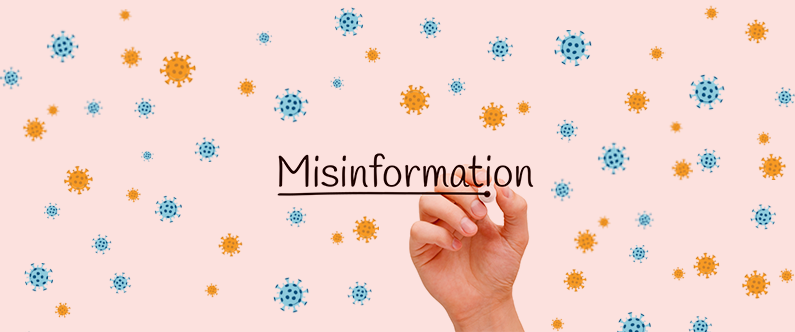Misinformation and Debunking Myths
 We need to be mindful about the consequences of misinformation
We need to be mindful about the consequences of misinformation
The spread of misinformation, rumors and myths since the initiation of the COVID-19 pandemic has been prevalent online, on social media and via instant messaging apps. This abundance of false or inaccurate information makes it difficult for people to find and believe in trustworthy sources and reliable guidance when they need it. Many of our friends and family may forward or share ‘information’ about COVID-19 without actually verifying the authenticity and reliability of the content.
Why is misinformation dangerous?
Believing false information and not believing credible or the right information are both problems. Many false or misleading stories are fabricated and shared without the quality being checked, and their intent is to deliberately deceive. Even if a small fraction of the public believes the misinformation, the consequences can be disastrous. Misinformation could end up gaining outsized influence because of how it is amplified on social media or on traditional media and can negatively affect human health especially mental health. It can circulate and be absorbed very quickly, changing people’s behavior, and potentially leading them to take greater risks. All this makes the pandemic much more severe, harming more people and jeopardizing the reach and sustainability of the current healthcare systems.
Source: Pan American Health Organization
We need to be mindful about the consequences of misinformation. People should be directed towards credible and trusted sources of information such as World Health Organization and national health authorities.
How can we tell fact from fiction?
- Do your own research
- When you see a post on social media, don’t assume it’s true
- It’s OK to question a post and search for an answer on your own
- Get your information from trusted news sites and other credible sources
- Talk to your friends and family about the importance of being responsible with information
Common Myths Debunked
Inaccurate and false information has been circulating about various aspects of the SAR-CoV-2 virus and the COVID-19 disease: how the virus originated, its cause, its mechanism of spread, diagnosis, and its treatment. Consequently, myths have become rampant. You may have heard people make statements such as the below or some variation thereof. We’ve broken these down:
Myth: ‘COVID-19 is not going to be an issue in the summer; hot weather kills micro-organisms’
Fact: Exposing yourself to the sun or temperatures higher than 25°C DOES NOT protect you from COVID-19. You can catch COVID-19, no matter how sunny or hot the weather is. Countries with hot weather have reported cases of COVID-19.
Myth: ‘I’m not getting enough oxygen because I wear masks’
Fact: The prolonged use of medical masks (surgical masks) when properly worn, DOES NOT cause carbon dioxide intoxication or oxygen deficiency for regular tasks. While exercising, the WHO recommends that people not wear masks as they may reduce the ability to breathe comfortably.
Myth: ‘I’m not as old as people who are contracting COVID-19, and I don’t have diabetes or hypertension, I’ll be fine’
Fact: Older people AND younger people can be infected by the COVID-19 virus. Older people, and people with pre-existing medical conditions such as asthma, diabetes, and heart disease appear to be more vulnerable to becoming severely ill with the virus, but this doesn’t mean that if you are young, you’ll never get it. WHO advises people of ALL ages to take steps to protect themselves from the virus.
Refer to the World Health Organization’s ‘Mythbusters’ for comprehensive facts that debunk myths around COVID-19.
Contributors: Ms. Yasmeen Kalverts, Ms. Raji Anand, Dr. Sohaila Cheema and Dr. Sathyanarayanan Doraiswamy
Editing: Mr. John Hayward